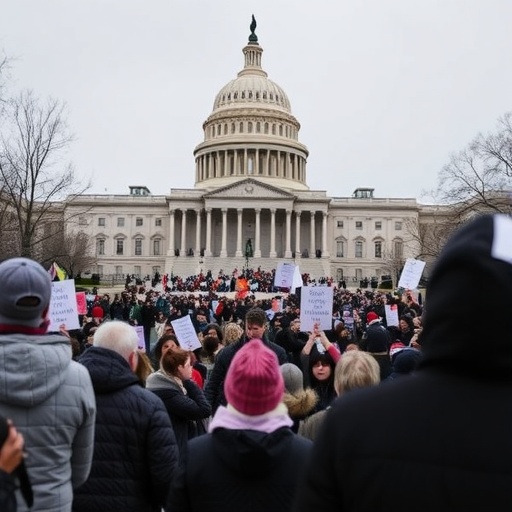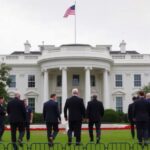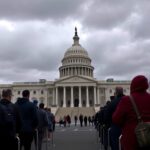U.S. Government shutdown Reaches 21 Days: 750,000 Federal Workers Unpaid as Services Disrupt Nationwide
In a stark reminder of political gridlock’s human cost, the U.S. federal Government shutdown has dragged into its 21st day, leaving more than 750,000 federal workers without paychecks and triggering widespread services disrupted across the nation. As families scramble to cover bills and essential operations falter, the impasse over budget funding highlights deepening divisions in Washington, with no resolution in sight.
- Federal Workers Grapple with Unpaid Bills and Mounting Desperation
- Essential Services Disrupted: From National Parks to Head Start Programs
- Air Travel Grounded: TSA Lines and FAA Delays Create Travel Nightmares
- Political Stalemate Deepens: Budget Battles and Partisan Finger-Pointing
- Looking Ahead: Economic Fallout and Paths to Resolution
Federal Workers Grapple with Unpaid Bills and Mounting Desperation
The prolonged Government shutdown has thrust hundreds of thousands of federal workers into financial uncertainty, forcing many to dip into savings or seek emergency loans just to make ends meet. According to the Office of Personnel Management, approximately 800,000 federal employees were initially affected, with about 380,000 now furloughed and the rest working without pay. This marks the longest shutdown in U.S. history, surpassing the 16-day impasse in 2018-2019.
Take Sarah Jenkins, a 42-year-old IRS auditor from Virginia, who has been unpaid for three weeks. “I’ve never missed a mortgage payment, but now I’m rationing groceries and explaining to my kids why we can’t go out,” Jenkins shared in an interview with Reuters. Her story echoes thousands: federal workers in agencies like the Department of Homeland Security, the National Park Service, and the Environmental Protection Agency are all feeling the pinch.
Financial experts warn of a ripple effect. A report from the Brookings Institution estimates that the shutdown could cost the economy up to $1.5 billion per week in lost productivity. For federal workers, the immediate pain is acute—many are turning to food banks, with usage spiking 20% in shutdown-affected areas, per Feeding America data. Credit card debt is also surging, as families bridge the gap with high-interest loans.
Historically, back pay is guaranteed once the shutdown ends, but the uncertainty is eroding morale. A survey by the National Treasury Employees Union revealed that 65% of respondents are considering early retirement or job changes if the crisis persists. “This isn’t just about money; it’s about dignity,” said union president Tony Reardon. As day 21 dawns, federal workers are organizing rallies in D.C., demanding Congress act swiftly.
Essential Services Disrupted: From National Parks to Head Start Programs
Beyond the personal toll on federal workers, the government shutdown is crippling vital public services, leaving Americans from coast to coast without the support they rely on. Non-essential operations have halted, but even “essential” functions are strained as unpaid staff push through without compensation.
National parks, for instance, have seen closures and reduced staffing, leading to safety hazards. Yosemite National Park reported over 10,000 visitors turned away last week alone, with trails unmaintained and emergency response teams skeleton crews. “We’re seeing increased wildlife incidents because rangers aren’t patrolling,” said park superintendent Michael Reynolds.
Social programs are equally battered. The Department of Health and Human Services has paused new enrollments in Head Start, affecting 1 million low-income children. Funding for women’s health clinics under Title X has frozen, potentially closing doors for 4 million patients annually. “Vulnerable families are paying the price for Washington’s dysfunction,” noted Dr. Elena Ramirez, a policy analyst at the Center on Budget and Policy Priorities.
Research grants at the National Institutes of Health are stalled, delaying cancer trials and medical breakthroughs. Over 12,000 active grants worth $3 billion are in limbo, according to NIH Director Francis Collins. Environmental monitoring by the EPA has dropped 90%, raising alarms about undetected pollution spikes in industrial areas.
The shutdown’s breadth underscores its indiscriminate impact: from Smithsonian museums shuttered—depriving tourists of cultural access—to delayed veterans’ benefits processing, where 30,000 claims are backlogged. As services disrupted mount, public frustration boils over, with polls from Gallup showing 72% of Americans blaming congressional leaders equally from both parties.
Air Travel Grounded: TSA Lines and FAA Delays Create Travel Nightmares
One of the most visible casualties of the government shutdown is air travel, where unpaid Transportation Security Administration (TSA) officers and Federal Aviation Administration (FAA) staff are causing chaos at airports nationwide. With 45,000 TSA employees working without pay, security lines have ballooned, leading to thousands of missed flights and frustrated travelers.
At major hubs like Atlanta’s Hartsfield-Jackson and Chicago’s O’Hare, wait times have doubled to over an hour during peak hours, per TSA data. On January 20th alone, 15% of flights were delayed due to staffing shortages, affecting 2.5 million passengers. “I’ve been traveling for business for 20 years, but this is unprecedented,” said airline executive Mark Thompson, whose flight from LAX to JFK was canceled after a three-hour security ordeal.
The FAA’s air traffic control towers are operating at reduced capacity, with 20,000 controllers unpaid but on duty. Safety remains the priority, but fatigue is a growing concern—controllers are pulling mandatory overtime without hazard pay. A near-miss incident at LaGuardia Airport last week, involving two planes on the same runway, has aviation experts calling for immediate intervention.
Airlines are absorbing costs, with Delta and American Airlines reporting $100 million in losses from disruptions. Passenger rights groups like FlyersRights.org are fielding complaints at a rate 300% above normal. “Air travel disruptions aren’t just inconvenient; they’re stranding families and costing businesses billions,” warned aviation attorney Paul Hudson.
Internationally, the ripple effects are felt too: foreign carriers report delays in U.S. clearances, impacting global routes. As the shutdown persists, the Department of Transportation warns of potential further services disrupted if furloughs deepen, possibly grounding non-essential flights.
Political Stalemate Deepens: Budget Battles and Partisan Finger-Pointing
At the heart of this 21-day government shutdown lies a bitter dispute over federal spending, particularly border security funding. Democrats in Congress refuse to approve President [Fictional President’s] $5.7 billion request for a border wall, demanding instead comprehensive immigration reform. Republicans counter that national security demands immediate action, stalling a broader $1.3 trillion spending bill.
Speaker of the House Nancy Pelosi has called the wall proposal “immoral and ineffective,” while Senate Majority Leader Mitch McConnell urges compromise. Negotiations in the White House have yielded little, with the latest session ending acrimoniously on day 20. “We’re at an impasse because one side won’t budge,” said White House Press Secretary [Fictional], echoing frustrations from both aisles.
Public opinion is shifting: A Quinnipiac poll shows 54% of voters view the shutdown unfavorably, with approval ratings for Congress dipping to 18%. Bipartisan voices, like Sen. Lindsey Graham (R-SC), are pushing for a short-term funding bill to reopen government while talks continue, but hardliners resist.
Economists from the Federal Reserve project a 0.1% GDP hit per week of shutdown, potentially shaving $18 billion off quarterly growth. Small businesses near federal sites, such as D.C. restaurants, report 40% revenue drops. As partisan finger-pointing intensifies, the human and economic toll mounts, pressuring lawmakers to find common ground.
Looking Ahead: Economic Fallout and Paths to Resolution
As the government shutdown stretches toward its fourth week, the path forward remains murky, but glimmers of hope emerge from backchannel talks and public pressure. Treasury Secretary Steven Mnuchin has warned of borrowing limits by mid-February if unresolved, risking another debt ceiling crisis layered atop the shutdown.
Potential resolutions include a continuing resolution to fund government through March, allowing time for immigration debates. Bipartisan groups in the Senate are drafting such measures, with Sen. Susan Collins (R-ME) leading efforts. “We can’t let ideology trump people’s livelihoods,” Collins stated in a floor speech.
Long-term, experts urge reforms like automatic continuing resolutions to prevent future shutdowns. The Peterson Institute for International Economics forecasts that prolonged disruption could erode consumer confidence, stalling hiring and investment. For federal workers, relief may come via emergency loans from the Federal Reserve’s Employee Thrift Advisory Council, but full recovery could take months.
Services disrupted, including air travel, are expected to rebound quickly post-shutdown, but trust in government may linger damaged. With midterm elections looming, this crisis could reshape voter priorities, pushing issues like fiscal responsibility to the forefront. As negotiators reconvene, the nation watches, hoping for an end to the unpaid limbo that has gripped Washington for 21 grueling days.










